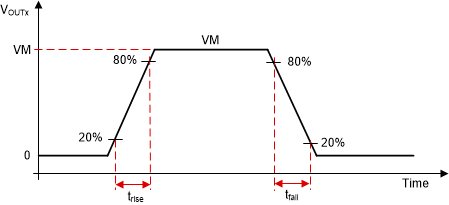ZHCSQ30 December 2022 DRV8317
PRODUCTION DATA
- 1
- 1 特性
- 2 应用
- 3 说明
- 4 Revision History
- 5 Device Comparison Table
- 6 Pin Configuration and Functions
- 7 Specifications
-
8 Detailed Description
- 8.1 Overview
- 8.2 Functional Block Diagram
- 8.3
Feature Description
- 8.3.1 Output Stage
- 8.3.2 Control Modes
- 8.3.3 Device Interface Modes
- 8.3.4 AVDD Linear Voltage Regulator
- 8.3.5 Charge Pump
- 8.3.6 Slew Rate Control
- 8.3.7 Cross Conduction (Dead Time)
- 8.3.8 Propagation Delay
- 8.3.9 Pin Diagrams
- 8.3.10 Current Sense Amplifiers
- 8.3.11 Protections
- 8.4 Device Functional Modes
- 8.5 SPI Communication
- 8.6 DRV8317 Registers
- 9 Application and Implementation
- 10Power Supply Recommendations
- 11Layout
- 12Device and Documentation Support
- 13Mechanical, Packaging, and Orderable Information
8.3.6 Slew Rate Control
An adjustable gate-drive current to the MOSFETs allows for driver output slew rate control. The MOSFET VDS slew rate is a critical factor in optimizing radiated emissions, energy and duration of diode recovery spikes and switching voltage transients related to parasitics. This slew rate is predominantly determined by the rate of gate charge to the MOSFETs as shown in Figure 8-9.
 Figure 8-9 Slew Rate
Control
Figure 8-9 Slew Rate
ControlThe slew rate of each half-bridge can be adjusted by SLEW pin in hardware variant or by SLEW_RATE register in SPI variant. The slew rate is calculated by the rise-time and fall-time of the voltage on OUTx pin as shown in Figure 8-10.
 Figure 8-10 Slew Rate
Measurement
Figure 8-10 Slew Rate
Measurement